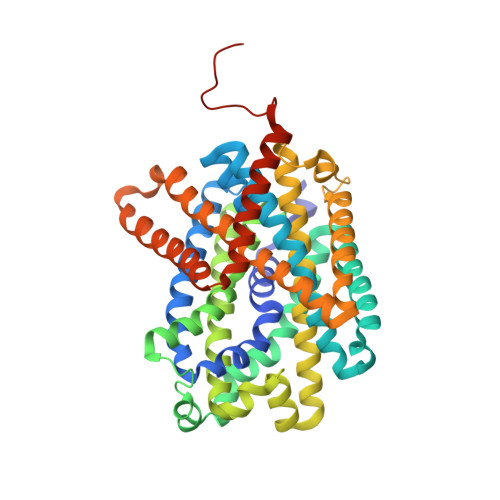Insights into the molecular basis for substrate binding and specificity of the wild-type L-arginine/agmatine antiporter AdiC.
Ilgu, H., Jeckelmann, J.M., Gapsys, V., Ucurum, Z., de Groot, B.L., Fotiadis, D.(2016) Proc Natl Acad Sci U S A 113: 10358-10363
- PubMed: 27582465
- DOI: https://doi.org/10.1073/pnas.1605442113
- Primary Citation of Related Structures:
5J4I, 5J4N - PubMed Abstract:
Pathogenic enterobacteria need to survive the extreme acidity of the stomach to successfully colonize the human gut. Enteric bacteria circumvent the gastric acid barrier by activating extreme acid-resistance responses, such as the arginine-dependent acid resistance system. In this response, l-arginine is decarboxylated to agmatine, thereby consuming one proton from the cytoplasm. In Escherichia coli, the l-arginine/agmatine antiporter AdiC facilitates the export of agmatine in exchange of l-arginine, thus providing substrates for further removal of protons from the cytoplasm and balancing the intracellular pH. We have solved the crystal structures of wild-type AdiC in the presence and absence of the substrate agmatine at 2.6-Å and 2.2-Å resolution, respectively. The high-resolution structures made possible the identification of crucial water molecules in the substrate-binding sites, unveiling their functional roles for agmatine release and structure stabilization, which was further corroborated by molecular dynamics simulations. Structural analysis combined with site-directed mutagenesis and the scintillation proximity radioligand binding assay improved our understanding of substrate binding and specificity of the wild-type l-arginine/agmatine antiporter AdiC. Finally, we present a potential mechanism for conformational changes of the AdiC transport cycle involved in the release of agmatine into the periplasmic space of E. coli.
Organizational Affiliation:
Institute of Biochemistry and Molecular Medicine, University of Bern, CH-3012 Bern, Switzerland; Swiss National Centre of Competence in Research TransCure, University of Bern, CH-3012 Bern, Switzerland;














